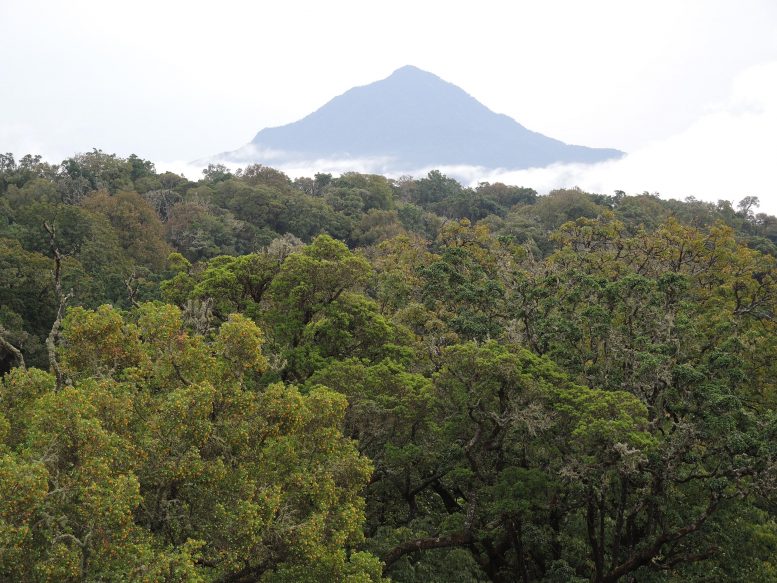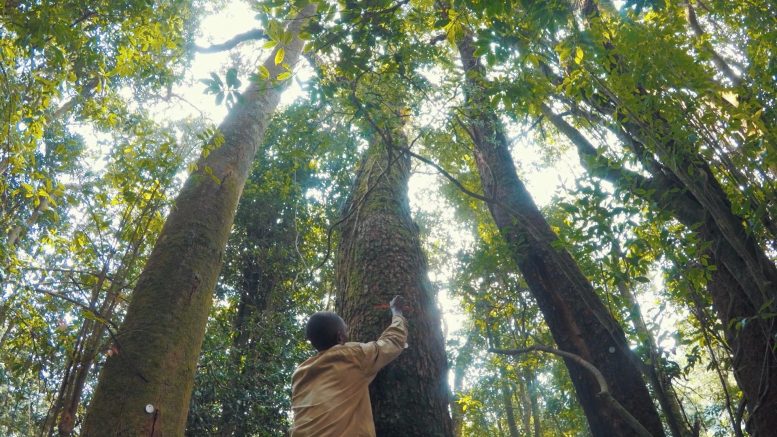Scientists studying tropical forests in Africa’s mountains were surprised to uncover how much carbon they store, and how fast some of these forests are being cleared.
The international study reported on August 25, 2021, in Nature, found that intact tropical mountain (or montane) forests in Africa store around 150 tonnes of carbon per hectare. This means that keeping a hectare of forest standing saves CO2 emissions equivalent to powering 100 homes with electricity for one year.
The study found that African mountain forests store more carbon per unit area than the Amazon rainforest and are similar in structure to lowland forests in Africa. Existing guidelines for African mountain forests – which assume 89 tonnes of carbon per hectare – greatly underestimate their role in global climate regulation.
The international team also investigated how much tropical mountain forest had been lost from the African continent in the past 20 years. They found that 0.8 million hectares (3,100 square miles) have been lost, mostly in the Democratic Republic of the Congo, Uganda, and Ethiopia, emitting over 450 million tonnes of CO2 into the atmosphere. If current deforestation rates continue, a further 0.5 million hectares (2,000 square miles) of these forests would be lost by 2030.
Lead author Dr. Aida Cuni-Sanchez, from the University of York’s Department of Environment and Geography and at Norwegian University of Life Sciences, said: “The results are surprising because the climate in mountains would be expected to lead to low carbon forests.
“The lower temperatures of mountains and the long periods they are covered by clouds should slow tree growth, while strong winds and steep unstable slopes might limit how big trees can get before they fall over and die.
“But unlike other continents, in Africa we found the same carbon store per unit area in lowland and mountain forests. Contrary to what we expected, large trees remain abundant in mountain forests, and these large trees (defined as having diameters over 70 cm) store a lot of carbon.”
Scientists measured 72,000 trees in 44 mountain sites in 12 African countries, from Guinea to Ethiopia, and south to Mozambique. In each mountain site, they established plots where they recorded the diameter, height, and species of every tree.
Researchers said that better knowledge about how much carbon mountain forests store is especially important for the ten African nations where the only tropical forests they have are those found on mountains.
“While we know what makes African forests special, we don’t yet know why they are different. It is possible that in Africa, the presence of large herbivores such as elephants plays an important role in mountain forest ecology, as these large animals disperse seeds and nutrients, and eat small trees creating space for others to grow larger, but this requires further investigation,” Dr Cuni-Sanchez added.
Co-author Dr. Phil Platts, from York’s Department of Environment and Geography and the IUCN’s Climate Change Specialist Group, said: “About five percent of Africa’s tropical mountain forests have been cleared since 2000, and in some countries, the rate exceeds 20 percent. Besides their importance for climate regulation, these forests are habitats for many rare and endangered species, and they provide very important water services to millions of people downstream”.
Most African nations have committed large amounts of land to forest restoration under the Bonn Challenge. Although forest restoration is important to mitigate climate change, avoiding deforestation is a greater priority.
Co-author Dr. Martin Sullivan, at the Department of Natural Sciences, Manchester Metropolitan University, added: “Previous carbon estimates for tropical mountain forests in Africa were much lower than the values we report in our study.
“We hope that these new data will encourage carbon finance mechanisms towards avoided deforestation in tropical mountains. As outlined in the Paris Agreement, reducing tropical deforestation in both lowland and mountain forests must be a priority.”
Co-author Dr. Gerard Imani, at the Department of Biology, Université Oficielle de Bukavu in DR Congo, added: “Carbon finance mechanisms could help improve conservation interventions on the ground – even within protected areas, deforestation, forest degradation and defaunation remain a challenge.”
Reference: “High aboveground carbon stock of African tropical montane forests” by Aida Cuni-Sanchez, Martin J. P. Sullivan, Philip J. Platts, Simon L. Lewis, Rob Marchant, Gérard Imani, Wannes Hubau, Iveren Abiem, Hari Adhikari, Tomas Albrecht, Jan Altman, Christian Amani, Abreham B. Aneseyee, Valerio Avitabile, Lindsay Banin, Rodrigue Batumike, Marijn Bauters, Hans Beeckman, Serge K. Begne, Amy C. Bennett, Robert Bitariho, Pascal Boeckx, Jan Bogaert, Achim Bräuning, Franklin Bulonvu, Neil D. Burgess, Kim Calders, Colin Chapman, Hazel Chapman, James Comiskey, Thales de Haulleville, Mathieu Decuyper, Ben DeVries, Jiri Dolezal, Vincent Droissart, Corneille Ewango, Senbeta Feyera, Aster Gebrekirstos, Roy Gereau, Martin Gilpin, Dismas Hakizimana, Jefferson Hall, Alan Hamilton, Olivier Hardy, Terese Hart, Janne Heiskanen, Andreas Hemp, Martin Herold, Ulrike Hiltner, David Horak, Marie-Noel Kamdem, Charles Kayijamahe, David Kenfack, Mwangi J. Kinyanjui, Julia Klein, Janvier Lisingo, Jon Lovett, Mark Lung, Jean-Remy Makana, Yadvinder Malhi, Andrew Marshall, Emanuel H. Martin, Edward T. A. Mitchard, Alexandra Morel, John T. Mukendi, Tom Muller, Felix Nchu, Brigitte Nyirambangutse, Joseph Okello, Kelvin S.-H. Peh, Petri Pellikka, Oliver L. Phillips, Andrew Plumptre, Lan Qie, Francesco Rovero, Moses N. Sainge, Christine B. Schmitt, Ondrej Sedlacek, Alain S. K. Ngute, Douglas Sheil, Demisse Sheleme, Tibebu Y. Simegn, Murielle Simo-Droissart, Bonaventure Sonké, Teshome Soromessa, Terry Sunderland, Miroslav Svoboda, Hermann Taedoumg, James Taplin, David Taylor, Sean C. Thomas, Jonathan Timberlake, Darlington Tuagben, Peter Umunay, Eustrate Uzabaho, Hans Verbeeck, Jason Vleminckx, Göran Wallin, Charlotte Wheeler, Simon Willcock, John T. Woods and Etienne Zibera, 25 August 2021, Nature.
DOI: 10.1038/s41586-021-03728-4
The research was funded by Marie Skłodowska-Curie Actions and National Geographic amongst other funders. All funders are listed in the acknowledgments of the paper.











Be the first to comment on "Tropical Forests in Africa’s Mountains Store More Carbon Than Previously Thought – But They’re Disappearing Fast"